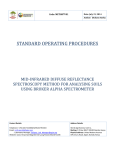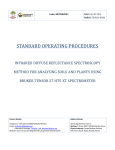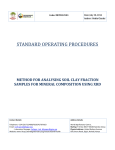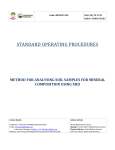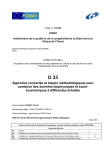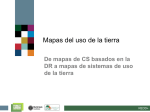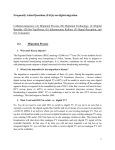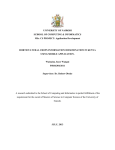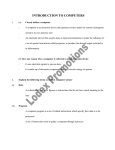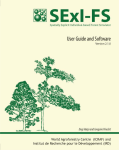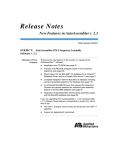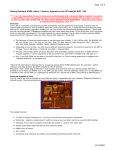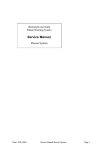Download STANDARD OPERATING PROCEDURES
Transcript
Date: July 30, 2014 Code: METH09V01 Author: Dickens Ateku STANDARD OPERATING PROCEDURES NEAR-INFRARED DIFFUSE REFLECTANCE SPECTROSCOPY METHOD FOR ANALYSING SOILS AND PLANTS USING BRUKER MULTI PURPOSE ANALYSER SPECTROMETER Contact Details: Address Details: Telephone: +254 (20) 7224000/4235/4279/4163 Email: [email protected] : Laboratory Manager, [email protected] Website: www. http://worldagroforestry.org/research/land-health World Agroforestry Centre, Mailing: P.O Box 30677-00100 Nairobi, Kenya Physical address: United Nations Avenue Off Limuru Road, Gigiri, Nairobi, Kenya STANDARD OPERATING PROCEDURE Code: METH 09V01 Title: Method for analysing samples for spectral characteristics in Mid IR range using MPA Date: July 31, 2014 Author: Dickens Ateku METHOD DOCUMENT CONTROL LOG Author(s) Verifiers Name and position Signature Dickens Ateku Alubaka -Senior Laboratory [signature for completeness and correctness of document] Technician Dickens Ateku Alubaka -Senior Laboratory [signature for completeness and correctness of document] Technician Beatrice Mwangi -Laboratory Technician Authorizer Elvis Weullow -Deputy Laboratory Manager [signature for completeness and correctness of document] [signature for completeness and correctness of document] Distribution of valid copies of this document: G 149 Infrared Spectroscopy Laboratory Revise before: Historical data Date retrieval: [date] [dates of previous issues] [to be filled in once the document has become obsolete and is archived] Changes in this version compared to previous version: [Describe what has changed in the text of this version compared to the previous version] 2 |M P A S O P STANDARD OPERATING PROCEDURE Code: METH 09V01 Title: Method for analysing samples for spectral characteristics in Mid IR range using MPA Date: July 31, 2014 Author: Dickens Ateku SCOPE AND APPLICATION This is a World Agroforestry Centre’s Soil-Plant Spectral Diagnostic Laboratory SOP for analysis of various chemical properties in both soils and plants using near IR spectra recorded with MPA module. The technique involves shinning of near infrared light on the samples and capturing of the diffuse reflected light in to raw file known as the interferogram. The spectrum thus recorded bears the qualitative and quantitative chemical aspect of the sample for further use with various data processing systems. This SOP is applicable to those doing analysis on infrared laboratory using MPA spectrometer Module. PRINCIPLE The MPA Module is designed for measurements in diffuse reflection and transmission. The optics of a diffuse reflection accessory is designed in such a way that detection of diffuse reflected light is optimized and the detection of specular reflected light is minimized. A DRIFT is an analyzing technique in FT-IR spectroscopy that makes use of the phenomenon of diffuse reflection. The key advantage of these techniques is that it enables analysis of strongly scattering and absorbing samples unlike transmission measurements and equally has high signal intensity. ABBREVIATIONS AND DEFINITIONS DRIFT –Diffuse Reflectance Fourier Transform spectroscopy. OPUS –Bruker’s Optical User Software STD – standard soil sample PVC - Poly Vinyl Chloride SOP – standard operating procedures NIR- near infra-red MPA - Multi-Purpose Analyze 3 |M P A S O P STANDARD OPERATING PROCEDURE Code: METH 09V01 Title: Method for analysing samples for spectral characteristics in Mid IR range using MPA Date: July 31, 2014 Author: Dickens Ateku RELATED DOCUMENT Multi-Purpose Analyzer Technical Manual Sample Reception and Preparation SOP NIR Workflow Infrared Health and Safety RELATED FORMS Login form Recording sheet SAFETY AND ENVIRONMENT Electrical hazards: Electrical systems must conform to the ICRAF standards. No shock hazards exist inside the instruments. Do not try to repair the faulty electrical system but call for assistance from an authorized service representative or an individual with training in electronic repair. The instruments require a third-wire protective grounding conductor. REQUIREMENTS Equipment a. Rolling pin b. PVC c. 2mm sieve d. Sample holders Small Petri dish 7cm diameter (Duroplan) Wide Petri dish 9 cm diameter (Duroplan) Vials Mug 9cm diameter Cuvette (for liquids –transmission) e. Spatula f. Non-fluffy cloth 4 |M P A S O P STANDARD OPERATING PROCEDURE Code: METH 09V01 Title: Method for analysing samples for spectral characteristics in Mid IR range using MPA Date: July 31, 2014 Author: Dickens Ateku NOTE: No reagents or chemicals used PROCEDURE Sample Analysis a. Power up the instrument and log into the OPUS software (Technician must get himself/herself familiarized with operating instructions of the instrument by going through the ICRAF soil and plant spectral diagnostic laboratory adopted version of user manual for MPA Module) b. Select the advance data collection option in OPUS and load the ICRAF soil and plant diagnostics laboratory adopted method by selecting and opening: ICRAF MPA_SPHEREMACROSAMPLEICRAF.XPM. (for solid samples – diffuse reflectance) Refer page 23 of the MPA manual. Or MPA_SAMPLECOMPARTMENTICRAF30.XPM (for liquid samples –transmission) (page 16). c. Create a folder that identifies the batch of soils being analyzed on the computer connected to the instrument d. Sample scanning process in carried out in OPUS LAB software (Refer page 33 of the MPA technical manual). e. As a part of quality control, the lab records spectra of selected standard soils, Grey standard and Kaolinite every day. These spectra are saved in a separate folder C:\ICRAF \RAW\DAILY STANDARDS. f. All spectra recorded on test samples should be saved in a separate folder. For example C:\ICRAF\RAW\SOTUBA SITE SOILS…………….for all Sotuba soils. Refer page 33 of the MPA SOP manual. g. Place the sample holder (petri dish) on the instrument against the Infra-red light and start scanning. Refer page 58 (MPA manual). 5 |M P A S O P QUALITY CONTROL Reference Material a. Reference standards: Infrared ICRAF laboratory uses Katumani, High Black Cracking Clay Soil (HBCCS) and Mua soils, Grey Standard and Kaolinite as reference standards. Everyday new spectra are recorded on these samples before analyzing test samples and checked against the previous records. Appropriate correction actions where necessary are implemented. Normally no adjustments are required. b. Blanks: A standard internal gold reference is used to correct the background c. Calibration: No calibration is required d. Duplicates: Not used e. Quick Compare: Perform opus quick compare of the standards to see how the instrument is performing (refer to the MPA Technical manual). 1. Data Validation a. Data Review Check the sample data and QC data to verify that the data to be reported is based on acceptable analyses and meet acceptable limits. Verify that Mua standard spectra have been entered into the appropriate logs. Verify that the results are saved in appropriate folder and format. Place data in the laboratory database. b. Supervisor Review Check the sample data and QC data to verify that the data to be reported is based on acceptable analyses and meet acceptable limits If any errors are found, return data for repeat analysis. REFERENCES 2. Multi-Purpose Analyzer User Manual, BRUKER OPTIC, 2003, page1 –page 48 STANDARD OPERATING PROCEDURE Code: METH 09V01 Title: Method for analysing samples for spectral characteristics in Mid IR range using MPA Date: July 31, 2014 Author: Dickens Ateku ANNEX 1. Work Flow Infra-red Laboratory Workflow (MPA &ASD) This laboratory uses infra red rays to analyze samples Objective: To provide fast high through put, cheap and accurate analysis (optimization of analysis) LEGEND From Preparation Factory Terminal point Action point All the processes for sample preparation are outlined in the sample preparation workflow and SOP Decision point Tape notes Stored data MPA Instrument? ASD Process route Operates in Near Infra-Red MPA (Multi Purpose Analyzer) *Sample Compartment ASD (Analytical Spectral Device) Operates in visible Near Infra-Red Module? (Transmission Mode) This is used to analyze liquid samples. Load the method then scan the sample Sample Scanning Integrating Sphere (Reflectance mode) This method uses diffuse reflectance to analyze samples Direct Method Load Method? Rotating Arm Place a wide petridish or the sample cup on the rotating arm Place petridish/vials on integrating sphere window Choose the method then scan the samples to obtain spectral signatures Put the sample petridish on lamp probe mug to obtain spectra Samples Scanning Data Processing All the data processes are illustrated in the SOP To Database *Method not frequently used 7 |M P A S O P STANDARD OPERATING PROCEDURE Code: METH 09V01 Title: Method for analysing samples for spectral characteristics in Mid IR range using MPA Date: July 31, 2014 Author: Dickens Ateku 2. Infrared MPA spectrometer standards fact sheets MPA Instrument calibration standards These are standards used for all analysis in the ICRAF Soil-Plant diagnostic laboratory. Heavy black cracking clay soils (HBCCS), Katumani, and MUA standards are run every day in the morning before you start any analysis and every time you start on a new site. Grey card, Kaolinite (clay) and White sand are commercial Standards which are run every day in the morning before you start any analysis and every time you start on a new site. 3. Quality Control fact sheet PROCESS DESCRIPTION Background Measurement The instrument is set in a way that it forces the user to perform Background measurement after every 1 hour. The measurement normally increases the signal to noise ratio of the spectrum produced (improves the quality of the spectra) Measurement of the selected soil standards. The standards used in ICRAF infrared laboratory are HBCCS, Katumani, MUA, Kaolinite, Grey card and White Sand. The measured spectra are used to monitor the performance of the instrument. Check on the quality of the spectrum measured Always monitor the instrument moisture. Ensure that the spectrum measured does not have any noise due to moisture and carbon dioxide. The moisture noise peaks are expected at around 3600cm and 1600cm wave numbers while the carbon dioxide peak is expected at around 2400cm wave numbers. 8 |M P A S O P








